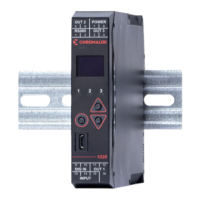34
12.3 Parameter Adjustment
Minimum Cooling
Cooling is enabled only above the temperature set be-
cause evaporation, with its associated cooling effect,
is not possible at temperatures below 100°C. Set this
>100, but it should be well below the normal operating
setpoint.
Note: In manual mode cooling is still possible below
this temperature.
Impulse Length
A fixed length for cooling pulses set by this parameter.
The ON pulses are this length for all cooling output val-
ues above 1% nominal cooling demand.
Relatively low values should be used, but remember that
the ratio of the Minimum Off Time vs Impulse Length
affects the maximum effective cooling (see above). Do
not allow this to limit cooling to the extent that insuf-
ficient cooling effect is available for the process.
The impulse length is also limited by the hardware (e.g.
the response time of your valve). Valves and electro-
mechanical relays should not be switched to quickly.
Consult the device manual or check with your supplier
for suitable minimum settings.
Minimum Off Time
The “off” time between pulses is varied dependent
upon the PID cooling demand. The Minimum Off Time
is the minimum allowed “off” time (but note that below
1% of cooling demand, the output is disabled).
The time set is hardware-dependent (e.g. the response
time of your valve). Generally, it is best set to the lowest
value compatible with the output switching device, but
remember that valves and electromechanical relays
should not be switched to quickly. Consult the device
manual or check with your supplier for suitable mini-
mum settings.
Remember that the ratio of the Minimum Off Time vs
Impulse Length affects the maximum effective cooling
(see above). Do not allow this to limit cooling to the
extent that insufficient cooling effect is available for the
process.
Non-Linear Adjust
This attenuates the cooling curve, and altering where
the output rate begins to increase more rapidly. The val-
ue can be reduced if the corrective action is too severe,
this reduces the non-linearity of the effective output.
To find an appropriate Non-Linear Adjust setting:
First set Minimum Cooling, Impulse Length and
Minimum Off Time to appropriate values (see
above), and initially set Non-Linear Adjust to 5. Use
Pre-Tune or manual tuning to adjust the controllers
PID settings to your process.
Using these settings, and observe the transition
from heating to cooling. If there is a noticeable
over-reaction, where the cooling is still too strong,
increase the Non-Linear Adjust value until the ef-
fect is reduced to acceptable levels. If the transition
becomes too slow, with effective cooling unaccept-
ably delayed, reduce the value set.
12.4 Soft Start Function
Soft Start is primarily intended to allow heaters to dry
out gradually at start-up condensation which can form
when the heaters are cold can cause damage if it evap-
orates too quickly.
Soft Start has its own setpoint, allowing a pre-defined
low-temperature dwell period which reduces the power
demand from the heaters, allowing moisture to evapo-
rate more slowly before going to full working tempera-
ture. During this period, it also minimizes the heater-on
times by reducing the cycle time and limiting the PID
power demand.
Note: Soft Start does not limit the instantaneous cur-
rent to the heaters when the output is on.
Activated by setting the parameters Soft Start Time
and Soft Start Setpoint.
1. When powered up the unit will control to the Soft
Start Setpoint. The control cycle time is 1/4 of the
value entered (subject to the minimum possible
value of 0.5s) and the maximum power demand is
limited to the Heat Power Limit value (set in the
Control menu). The reduced cycle time is used dur-
ing the soft start phase.
2. After reaching the Soft Start Setpoint the Soft Start
Time begins. The timer starts as soon as the PV is
equal to Soft Start Setpoint – 1. The Soft Start Set-
point is maintained until this time has elapsed.
3. When Soft Start Timer expires, the unit returns
to normal operation. It controls to the normal set-
point, the cycle time reverts to the value set and the
Heat Power Limit is no longer used.
Remember, when using the Soft Start
feature the Heat Power Limit is only
active from power-on and during the Soft
Start Time. It remains in use until the Soft
Start timer expires or all the time if no
Soft Start time is OFF.

